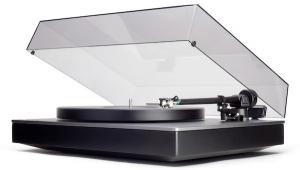SME 10 turntable Page 4
The Model 10's predecessor in my system, the Basis Debut turntable that I reviewed in January, sounds softer, more plush, and somewhat more rich overall, particularly in the midrange—at least with the Graham or Immedia arms. The 10/M10 combo had far superior focus, clarity, and image specificity, though I felt that the M10 arm was not retrieving low-level details from familiar records—much as the Yorke arm hadn't on the Yorke 'table, though tonally that system, too, was a fine, essentially neutral performer.
Enter the SME IV.Vi tonearm
A few weeks into the review period, Sumiko sent me a tonearm upgrade: the SME IV.Vi, which features a nondetachable headshell, lower-tolerance (higher-quality) Abec 7 bearings, SME's more sophisticated mounting system, internal Magnan Vi wiring, a damping trough, a better finish, and a price of $2750.
The IV.Vi tonearm raises the Model 10's price to $8250, and it raised the level of performance as well. With the IV.Vi on the 'table, there was a noticeable improvement in low-level resolution, retrieval of inner detail, and, not surprisingly, soundstage depth, with back-of-hall events coming into finer focus. The IV.Vi helped create a bigger, more finely focused, somewhat smoother picture that bettered in every way an already impressive performance. It certainly forced me to reassess my opinion of SME arms in general. The bad rap on SME arms is their "plummy, exaggerated bass." I didn't hear it. And believe me—if it had been there, the Infinity Prelude speakers with built-in 850Wpc subwoofers (20-100Hz, ±4dB in my room) would have let me hear it.
Yet without auditioning a known arm on the 10 'table, or the IV.Vi on my reference Yorke, I can't tell you whether or not the performance of the 10/IV.Vi combo was the result of product synergy. Bob Graham, who makes armboards for VPI, Linn, Clearaudio, and SME's 20 and 30 turntables, promised an adapter for the 10. I'll follow up this review with an audition of the 10 with the Graham 2.0 arm.
Switching out the Temper Supreme between the Graham/Yorke and SME 10/IV.Vi combos, I noted a similar rhythmic clarity and low-frequency slam. These unsprung, plinthless, non-acrylic designs share much in common sonically, though the Yorke (on the Vibraplane active isolation platform) was somewhat richer in the midbass and thus slightly more mellow overall. The SME combo was clearly more dynamic, punchy, and present.
Conclusion
If you value tight focus, slam, bass control and weight, cleanly sharpened "edge," black backgrounds, and relentlessly "right" rhythmic performance, and are willing to give up a bit of the cushy, floaty lushness and richness in the midrange that you get with the Basis Debut and VPI TNT 'tables, as well as the ultimate resolution of low-level inner detail—the sound of the stock SME Model 10 with M10 tonearm could be not only your first turntable of the new millennium, but the last 'table/arm you'll ever buy. The 10/M10 is comfortably up there with the finest-performing 'tables I've ever auditioned—and you can always upgrade the arm, which is almost a freebie anyway. (According to importer Sumiko, the $5995 combo price is due to rise before the end of the year.)
The 10's magnificent build quality, compact design, ease of use, and rock-solid performance should keep most analog lovers happy for many years to come. Add $2500, and the SME IV.Vi arm levels the playing field with the Yorke/Graham and Yorke/Immedia combos, though all three systems sound different from one another.
The M10 arm's detachable headshell reduces rigidity but allows azimuth adjustability. The fixed-headshell IV.Vi doesn't allow you to adjust azimuth, but it could be argued that azimuth is a less critical, perhaps even an unnecessary adjustment in a fixed-bearing design, especially given the level of cartridge likely to be used. Even in the fixed-headshell IV.Vi, SME terminates the arm wires in pins, inserting an unnecessary break in the critical low-voltage connection from cartridge to preamp. I wish the connection was direct to the DIN plug. How will the Graham 2.0 fare on the SME 10? Stay tuned.
If this 'table/arm combo has a weakness (I'm grasping here), it's that its focus, clarity, and transient authority come at a small price: a slight hardness and "skeletal" harmonic quality from the midbass to the upper midrange, something your choice of cartridge can probably work around.
If I were to (roughly) compare the SME or Simon Yorke 'tables to the Basis or TNT in terms of cartridge sound, the SME/Yorke would be akin to a Transfiguration Temper Supreme or Parnassus D.C.t, and the Basis/TNT would be closer to a Koetsu or Cardas Heart/Benz Ruby. Lovers of lush sound may not be happy here, but if I were hunting for a new turntable, I'd be on the SME's trail. Can SME's $22,000 Model 30 really be that much better?
- Log in or register to post comments




















































